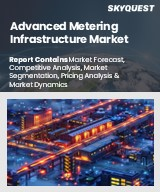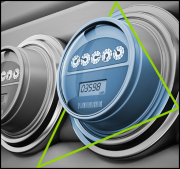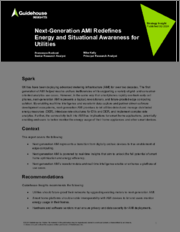
|
시장보고서
상품코드
1494840
세계의 지능형 검침 인프라(AMI) 시장 예측 : 제품 유형별, 최종 사용자별, 지역별 분석(-2030년)Advanced Metering Infrastructure Market Forecasts to 2030 - Global Analysis By Product Type (Smart Metering Devices and Software), End User (Industrial, Commercial and Residential) and By Geography |
||||||
Stratistics MRC에 따르면 세계의 지능형 검침 인프라 시장은 2024년 265억 달러로 추정되고, 예측 기간 동안 CAGR은 16.2%로 성장할 전망이며, 2030년에는 652억 달러에 이를 전망입니다.
AMI(Advanced Metering Infrastructure)는 미터와 전력 회사 간의 양방향 통신을 가능하게 하는 전력 회사 미터의 최신 시스템입니다. 기존의 미터와 달리 AMI 미터는 소비 데이터를 자주, 종종 실시간으로 기록 및 전송할 수 있습니다. 이 기술은 보다 정확하고 시기 적절한 청구를 가능하게 하고 에너지 사용 패턴의 모니터링을 강화합니다. AMI는 통상, 무선이나 전력선 통신 등 다양한 네트워크를 통해 데이터를 송신할 수 있는 통신 모듈을 탑재한 스마트 미터의 배치를 수반합니다.
마컴 캐피탈에 따르면 2022년 1월에 전국에서 가장 많은 스마트 미터가 설치된 것은 인도의 우타르 프라데시 주에서 그 수는 115만을 넘었습니다.
증가하는 업무 효율화 수요
스마트 미터, 통신 네트워크 및 데이터 관리 시스템을 통합한 고급 시스템인 첨단 계측 인프라를 사용하면 전력 회사가 에너지 소비를 원격으로 모니터링하고 보다 효율적으로 관리할 수 있습니다. 산업계와 소비자 모두 자원 이용 최적화와 비용 절감을 요구하고 있으며, AMI 솔루션의 도입은 점점 필수가 되고 있습니다. AMI의 실시간 데이터 수집 및 분석 기능은 계측 프로세스를 간소화할 뿐만 아니라 수요 예측, 부하 분산 및 정전 관리를 위한 실용적인 인사이트를 유틸리티 기업에 제공합니다.
데이터 프라이버시 및 보안
첨단 계측 인프라(AMI) 시장에서는 데이터의 프라이버시 및 보안에 대한 우려가 큰 장벽이 되고 있습니다. 에너지 소비에 대한 세분화된 데이터를 수집하는 스마트 미터의 보급에 따라 소비자는 개인 정보 유출 가능성에 대한 경계감을 강화하고 있습니다. 기밀 데이터 수집 및 전송은 무단 액세스, 데이터 유출, 제3자의 악용 가능성에 대한 우려를 야기합니다. 그 결과 이러한 우려가 AMI 솔루션의 보급을 방해하고 있습니다. 소비자와 규제기관은 소비자의 프라이버시를 보호하고 데이터의 안전성을 확보하기 위한 견고한 세이프 가드를 요구하고 있으며, 시장의 성장과 기술 혁신의 발판이 되고 있습니다.
에너지 절약 의식 증가
AMI 시스템은 에너지 소비의 실시간 모니터링 및 관리를 가능하게 하여 전력 회사와 소비자 모두 에너지 사용에 대한 충분한 정보를 기반으로 의사 결정을 내릴 수 있습니다. 환경의 지속가능성에 대한 의식이 높아지고 이산화탄소 배출량을 줄일 필요성이 높아지는 가운데 세계 정부와 조직은 에너지 절약을 추진하기 위한 정책과 이니셔티브를 실시했습니다. 첨단 계측 인프라는 에너지 소비 패턴에 대한 정확하고 세밀한 데이터를 제공하고, 적극적인 개입과 효율 개선을 촉진함으로써 이 대처에서 중요한 역할을 하고 있습니다.
레거시 인프라
구식 인프라는 지능형 검침 인프라(AMI) 시장의 발전에 큰 과제를 가져왔습니다. 구식 시스템은 최신 스마트 계측 기술을 원활하게 통합하는 데 필요한 유연성과 상호 운용성이 부족합니다. 이러한 비호환성은 도입 비용 상승, 배포 복잡성, 데이터 관리 효율성 저하로 이어집니다. 구식 인프라에는 소비자의 기밀 데이터를 보호하는 데 필요한 사이버 보안 조치가 부족한 경우가 많으며 개인 정보 보호 및 데이터 침해에 대한 우려가 커지고 있습니다. 또한 노후화된 인프라에 대한 의존은 AMI 솔루션의 확장성과 혁신의 잠재력을 제한하고 유틸리티 기업이 진화하는 에너지 수요와 고객의 요구에 적응할 수 있는 능력을 방해합니다.
COVID-19의 영향 :
COVID-19의 대유행은 첨단 계측 인프라(AMI) 시장에 큰 영향을 미쳤습니다. 처음에는 세계 공급망의 혼란으로 인해 제조 지연 및 필수 부품 부족이 발생하여 AMI 시스템의 배포가 방해되었습니다. 봉쇄 조치와 사회적 거리를 두는 프로토콜은 현장 설치 및 유지 보수 활동을 지연시키고 프로젝트 일정에 영향을 미쳤습니다. 그러나 팬데믹은 또한 효율적인 유틸리티 운영을 보장하고 원격 관리 기능을 가능하게 하는 AMI 솔루션의 중요성을 부각시켰습니다.
예측 기간 동안 스마트 미터링 장치 부문이 최대화될 전망
에너지 관리를 최적화하고 유틸리티 운영을 강화하는 혁신적인 기술을 도입함으로써 스마트 미터링 장치 분야는 예측 기간 동안 최대가 될 전망입니다. 이러한 장치는 실시간 데이터 수집, 원격 모니터링, 양방향 통신 기능 등의 최첨단 기능을 채택하여 유틸리티 사업자가 전기, 가스, 수도의 배전망을 효율적으로 관리할 수 있도록 합니다. 스마트 미터를 인프라에 통합함으로써 유틸리티 사업자는 소비 데이터 수집, 고장 탐지, 진단 실행을 원격으로 수행할 수 있어 효율성 향상, 운영 비용 절감, 고객 서비스 강화로 이어집니다.
예측 기간 동안 CAGR이 가장 높을 것으로 예상되는 것은 비즈니스 부문
예측 기간 동안 CAGR이 가장 높을 것으로 예상되는 것은 비즈니스 부문입니다. 기업이 보다 높은 효율성과 지속가능성을 추구함에 따라 고급 측정 솔루션에 대한 수요가 급증하고 있습니다. AMI는 상업 단체가 에너지 소비를 실시간으로 모니터링하고 관리할 수 있게 하고, 사용 패턴에 대한 세밀한 인사이트를 제공하고, 자원 이용을 최적화하기 위한 사전 대책을 촉진합니다. AMI를 IoT 및 데이터 분석과 같은 다른 스마트 기술과 통합함으로써 기업은 예측 보전 전략을 구현하고 비용 절감을 위한 영역을 파악하고 전반적인 운영 효율성을 높일 수 있습니다.
최대 점유율을 차지하는 지역
북미는 예상 기간 동안 시장에서 가장 큰 점유율을 차지합니다. 이 지역 수요 반응 프로그램을 통해 전력 회사는 수요가 높은 시간대에 전력 사용량을 조정하도록 소비자에게 인센티브를 제공하여 최고 수요를 관리할 수 있습니다. 첨단 계측 인프라를 통해 유틸리티 기업은 에너지 소비를 실시간으로 원격 모니터링 및 제어할 수 있어 소비자에게 사용 패턴에 대한 인사이트를 제공하여 지역 전체에서 보다 효율적인 에너지 이용을 촉진하고 있습니다. 수요 반응 프로그램에 참여함으로써 소비자는 송전망 안정에 기여하고 비용이 많이 드는 인프라 정비의 필요성을 줄일 수 있습니다. 이러한 요소가 지역 성장을 뒷받침하고 있습니다.
CAGR이 가장 높은 지역 :
유럽은 예측 기간 동안 수익성이 높은 성장을 이룰 것으로 추정됩니다. 에너지 효율, 지속가능성, 송전망의 현대화에 중점을 둔 유럽 정부는 고도 계측 시스템의 채용을 의무화하는 엄격한 규제를 실시했습니다. 이러한 규제는 전력 회사에 에너지 소비의 실시간 모니터링을 가능하게 하고 더 정확한 과금을 가능하게 하는 스마트 미터의 도입을 요구하는 경우가 많습니다. 그 결과 유럽의 AMI 시장은 규제 요건을 충족하고 에너지 지속가능성 목표를 달성해야 하는 필요성에 의해 상당한 성장을 이루고 있습니다.
무료 맞춤설정 서비스
이 보고서를 구독하는 고객은 다음 무료 맞춤설정 옵션 중 하나를 사용할 수 있습니다.
- 기업 프로파일
- 추가 시장 기업의 종합적 프로파일링(3개사까지)
- 주요 기업의 SWOT 분석(3개사까지)
- 지역 세분화
- 고객의 관심에 응한 주요국 시장 추계, 예측 및 CAGR(주 : 타당성 확인에 따름)
- 경쟁 벤치마킹
- 제품 포트폴리오, 지리적 존재 및 전략적 제휴에 기반한 주요 기업 벤치마킹
목차
제1장 주요 요약
제2장 서문
- 개요
- 이해관계자
- 조사 범위
- 조사 방법
- 데이터 마이닝
- 데이터 분석
- 데이터 검증
- 조사 접근
- 조사 정보원
- 1차 조사 정보원
- 2차 조사 정보원
- 전제조건
제3장 시장 동향 분석
- 성장 촉진요인
- 억제요인
- 기회
- 위협
- 제품 분석
- 최종 사용자 분석
- 신흥 시장
- COVID-19의 영향
제4장 Porter's Five Forces 분석
- 공급기업의 협상력
- 구매자의 협상력
- 대체품의 위협
- 신규 진입업자의 위협
- 경쟁 기업간 경쟁 관계
제5장 세계의 지능형 검침 인프라(AMI) 시장 : 제품 유형별
- 스마트 미터 장치
- 물
- 전기
- 가스
- 소프트웨어
- 미터 데이터 관리
- 미터 데이터 분석
제6장 세계의 지능형 검침 인프라(AMI) 시장 : 최종 사용자별
- 산업
- 상업
- 주택
제7장 세계의 지능형 검침 인프라(AMI) 시장 : 지역별
- 북미
- 미국
- 캐나다
- 멕시코
- 유럽
- 독일
- 영국
- 이탈리아
- 프랑스
- 스페인
- 기타 유럽
- 아시아태평양
- 일본
- 중국
- 인도
- 호주
- 뉴질랜드
- 한국
- 기타 아시아태평양
- 남미
- 아르헨티나
- 브라질
- 칠레
- 기타 남미
- 중동 및 아프리카
- 사우디아라비아
- 아랍에미리트(UAE)
- 카타르
- 남아프리카
- 기타 중동 및 아프리카
제8장 주요 발전
- 계약, 파트너십, 협업 및 합작투자(JV)
- 인수 및 합병
- 신제품 발매
- 사업 확대
- 기타 주요 전략
제9장 기업 프로파일링
- ABB Ltd
- Aclara Technologies LLC
- Badger Meter Inc
- Cisco Systems Inc
- Echelon Corporation
- Elster Group GmbH
- Honeywell International Inc
- IBM Corporation
- Oracle Corporation
- Schneider Electric SE
- Siemens AG
- Toshiba Corporation
- Trilliant Holdings Inc
According to Stratistics MRC, the Global Advanced Metering Infrastructure Market is accounted for $26.5 billion in 2024 and is expected to reach $65.2 billion by 2030 growing at a CAGR of 16.2% during the forecast period. Advanced Metering Infrastructure (AMI) refers to a modern system of utility meters that enable two-way communication between the meter and the utility company. Unlike traditional meters, AMI meters can record and transmit consumption data at frequent intervals, often in real-time. This technology allows for more accurate and timely billing, as well as enhanced monitoring of energy usage patterns. AMI typically involves the deployment of smart meters equipped with communication modules that can transmit data over various networks, such as wireless or powerline communication.
According to Mercom Capital, the state of Uttar Pradesh in India had the most smart meters installed nationwide in January 2022, with over 1.15 million of them.
Market Dynamics:
Driver:
Rising demand for operational efficiency
Advanced Metering Infrastructure, a sophisticated system integrating smart meters, communication networks, and data management systems, enables utilities to remotely monitor and manage energy consumption more efficiently. As industries and consumers alike seek to optimize resource utilization and reduce costs, the adoption of AMI solutions becomes increasingly imperative. The real-time data collection and analytics capabilities of AMI not only streamline metering processes but also empower utilities with actionable insights for demand forecasting, load balancing, and outage management.
Restraint:
Data privacy and security
Data privacy and security concerns have become significant barriers in the Advanced Metering Infrastructure (AMI) market. With the proliferation of smart meters, collecting granular data on energy consumption, consumers are increasingly wary of potential breaches of their personal information. The collection and transmission of sensitive data raise concerns about unauthorized access, data breaches, and potential misuse by third parties. Consequently, these concerns hinder the widespread adoption of AMI solutions as consumers and regulatory bodies demand robust safeguards to protect their privacy and ensure data security, slowing down the market's growth and innovation.
Opportunity:
Increasing awareness about energy conservation
AMI systems enable real-time monitoring and management of energy consumption, empowering both utilities and consumers to make informed decisions about energy usage. With the rising awareness of environmental sustainability and the need to reduce carbon footprints, governments and organizations worldwide are implementing policies and initiatives to promote energy conservation. Advanced metering infrastructure plays a crucial role in this endeavor by providing accurate and granular data on energy consumption patterns, facilitating targeted interventions and efficiency improvements.
Threat:
Legacy infrastructure
Legacy infrastructure poses significant challenges to the advancement of the Advanced Metering Infrastructure (AMI) market. Outdated systems lack the flexibility and interoperability needed to integrate modern smart metering technologies seamlessly. This incompatibility leads to higher implementation costs, increased complexity in deployment, and compromised efficiency in data management. Legacy infrastructure often lacks the necessary cybersecurity measures to protect sensitive consumer data, raising concerns about privacy and data breaches. The reliance on aging infrastructure also limits the scalability and innovation potential of AMI solutions, hindering utilities' ability to adapt to evolving energy demands and customer needs.
Covid-19 Impact:
The COVID-19 pandemic significantly impacted the Advanced Metering Infrastructure (AMI) market. Initially, the global supply chain disruptions caused manufacturing delays and shortages of essential components, hindering the deployment of AMI systems. Lockdown measures and social distancing protocols slowed down field installations and maintenance activities, affecting project timelines. However, the pandemic also underscored the importance of AMI solutions in ensuring efficient utility operations and enabling remote management capabilities.
The Smart Metering Devices segment is expected to be the largest during the forecast period
Smart Metering Devices segment is expected to be the largest during the forecast period by introducing innovative technologies that optimize energy management and enhance utility operations. These devices employ cutting-edge functionalities such as real-time data collection, remote monitoring, and two-way communication capabilities, enabling utilities to efficiently manage electricity, gas, and water distribution networks. By integrating smart meters into the infrastructure, utilities can remotely gather consumption data, detect faults, and perform diagnostics, leading to improved efficiency, reduced operational costs and enhanced customer service.
The Commercial segment is expected to have the highest CAGR during the forecast period
Commercial segment is expected to have the highest CAGR during the forecast period. As businesses strive for greater efficiency and sustainability, the demand for advanced metering solutions has surged. AMI enables commercial entities to monitor and manage their energy consumption in real-time, providing granular insights into usage patterns and facilitating proactive measures to optimize resource utilization. The integration of AMI with other smart technologies like IoT and data analytics enables businesses to implement predictive maintenance strategies, identify areas for cost savings, and enhance overall operational efficiency.
Region with largest share:
North America region commanded the largest share of the market over the extrapolated period. Demand Response Programs across the region enable utilities to manage peak demand by incentivizing consumers to adjust their electricity usage during periods of high demand. Through advanced metering infrastructure, utilities can remotely monitor and control energy consumption in real-time, offering consumers insights into their usage patterns and encouraging more efficient energy practices throughout the region. By participating in demand response programs, consumers contribute to grid stability and reduce the need for costly infrastructure upgrades. These elements are boosting the regional growth.
Region with highest CAGR:
Europe region is estimated to witness profitable growth during the projection period. With a focus on energy efficiency, sustainability, and grid modernization, European governments have implemented stringent regulations mandating the adoption of advanced metering systems. These regulations often require utilities to deploy smart meters, which enable real-time monitoring of energy consumption and facilitate more accurate billing across the region. As a result, the AMI market in Europe is experiencing substantial growth, driven by the necessity to meet regulatory requirements and achieve energy sustainability goals.
Key players in the market
Some of the key players in Advanced Metering Infrastructure market include ABB Ltd, Aclara Technologies LLC, Badger Meter Inc, Cisco Systems Inc, Echelon Corporation, Elster Group GmbH, Honeywell International Inc, IBM Corporation, Oracle Corporation, Schneider Electric SE, Siemens AG, Toshiba Corporation and Trilliant Holdings Inc.
Key Developments:
In October 2022, The Linux Foundation (LF) Energy has announced the Super Advanced Meter (SAM), which focuses on a widely applicable smart meter data gateway. The new software is expected to hasten both the energy transition and the transformation of the meter into a reliable virtual node in the energy grid. The main objective of the project is a broadly applicable smart meter data gateway.
In July 2022, ITRON, Inc. announced the establishment of the Iron Engage Sales Channel Partner Program for utilities and municipalities in Asia-Pacific. With the aid of Itron Engage's expansion, trustworthy, highly skilled partners now have access to the tools, support, and training they need to apply Iron's solutions to benefit their customers and improve energy and water management.
Product Types Covered:
- Smart Metering Devices
- Software
End Users Covered:
- Industrial
- Commercial
- Residential
Regions Covered:
- North America
- US
- Canada
- Mexico
- Europe
- Germany
- UK
- Italy
- France
- Spain
- Rest of Europe
- Asia Pacific
- Japan
- China
- India
- Australia
- New Zealand
- South Korea
- Rest of Asia Pacific
- South America
- Argentina
- Brazil
- Chile
- Rest of South America
- Middle East & Africa
- Saudi Arabia
- UAE
- Qatar
- South Africa
- Rest of Middle East & Africa
What our report offers:
- Market share assessments for the regional and country-level segments
- Strategic recommendations for the new entrants
- Covers Market data for the years 2022, 2023, 2024, 2026, and 2030
- Market Trends (Drivers, Constraints, Opportunities, Threats, Challenges, Investment Opportunities, and recommendations)
- Strategic recommendations in key business segments based on the market estimations
- Competitive landscaping mapping the key common trends
- Company profiling with detailed strategies, financials, and recent developments
- Supply chain trends mapping the latest technological advancements
Free Customization Offerings:
All the customers of this report will be entitled to receive one of the following free customization options:
- Company Profiling
- Comprehensive profiling of additional market players (up to 3)
- SWOT Analysis of key players (up to 3)
- Regional Segmentation
- Market estimations, Forecasts and CAGR of any prominent country as per the client's interest (Note: Depends on feasibility check)
- Competitive Benchmarking
- Benchmarking of key players based on product portfolio, geographical presence, and strategic alliances
Table of Contents
1 Executive Summary
2 Preface
- 2.1 Abstract
- 2.2 Stake Holders
- 2.3 Research Scope
- 2.4 Research Methodology
- 2.4.1 Data Mining
- 2.4.2 Data Analysis
- 2.4.3 Data Validation
- 2.4.4 Research Approach
- 2.5 Research Sources
- 2.5.1 Primary Research Sources
- 2.5.2 Secondary Research Sources
- 2.5.3 Assumptions
3 Market Trend Analysis
- 3.1 Introduction
- 3.2 Drivers
- 3.3 Restraints
- 3.4 Opportunities
- 3.5 Threats
- 3.6 Product Analysis
- 3.7 End User Analysis
- 3.8 Emerging Markets
- 3.9 Impact of Covid-19
4 Porters Five Force Analysis
- 4.1 Bargaining power of suppliers
- 4.2 Bargaining power of buyers
- 4.3 Threat of substitutes
- 4.4 Threat of new entrants
- 4.5 Competitive rivalry
5 Global Advanced Metering Infrastructure Market, By Product Type
- 5.1 Introduction
- 5.2 Smart Metering Devices
- 5.2.1 Water
- 5.2.2 Electricity
- 5.2.3 Gas
- 5.3 Software
- 5.3.1 Meter Data Management
- 5.3.2 Meter Data Analytics
6 Global Advanced Metering Infrastructure Market, By End User
- 6.1 Introduction
- 6.2 Industrial
- 6.3 Commercial
- 6.4 Residential
7 Global Advanced Metering Infrastructure Market, By Geography
- 7.1 Introduction
- 7.2 North America
- 7.2.1 US
- 7.2.2 Canada
- 7.2.3 Mexico
- 7.3 Europe
- 7.3.1 Germany
- 7.3.2 UK
- 7.3.3 Italy
- 7.3.4 France
- 7.3.5 Spain
- 7.3.6 Rest of Europe
- 7.4 Asia Pacific
- 7.4.1 Japan
- 7.4.2 China
- 7.4.3 India
- 7.4.4 Australia
- 7.4.5 New Zealand
- 7.4.6 South Korea
- 7.4.7 Rest of Asia Pacific
- 7.5 South America
- 7.5.1 Argentina
- 7.5.2 Brazil
- 7.5.3 Chile
- 7.5.4 Rest of South America
- 7.6 Middle East & Africa
- 7.6.1 Saudi Arabia
- 7.6.2 UAE
- 7.6.3 Qatar
- 7.6.4 South Africa
- 7.6.5 Rest of Middle East & Africa
8 Key Developments
- 8.1 Agreements, Partnerships, Collaborations and Joint Ventures
- 8.2 Acquisitions & Mergers
- 8.3 New Product Launch
- 8.4 Expansions
- 8.5 Other Key Strategies
9 Company Profiling
- 9.1 ABB Ltd
- 9.2 Aclara Technologies LLC
- 9.3 Badger Meter Inc
- 9.4 Cisco Systems Inc
- 9.5 Echelon Corporation
- 9.6 Elster Group GmbH
- 9.7 Honeywell International Inc
- 9.8 IBM Corporation
- 9.9 Oracle Corporation
- 9.10 Schneider Electric SE
- 9.11 Siemens AG
- 9.12 Toshiba Corporation
- 9.13 Trilliant Holdings Inc



















